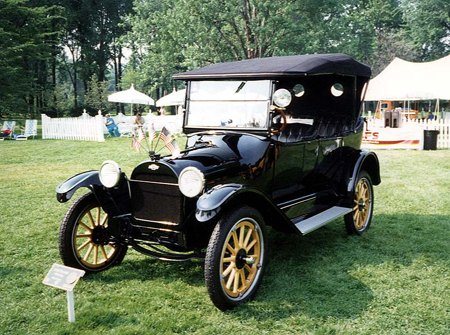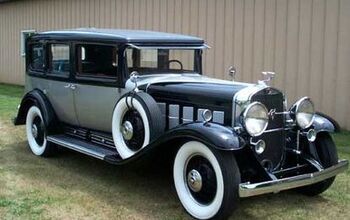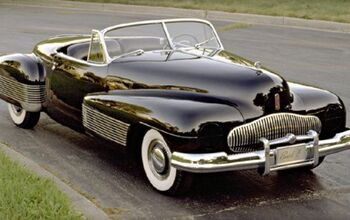General Motors' Branding Fiasco Part Two – Chevrolet's ADD

During the American car industry’s formative years, entrepreneurs started car companies left and right, jostling for quick profits and market share. Flint Rock native William Durant had a meta vision: agglomerate the best of the new automakers to create an empire called General Motors. This he did, through endless charm and clever financing. But Durant gambled too much too often, and lost control of his brainchild. The Chevrolet brand was born out of wedlock, to fund Billy Durant’s comeback.
Durant convinced Swiss-born race car driver Louis Chevrolet to lend his name and engineering talents to the start-up. Chevy launched its first car in 1912. The success of the “Classic Six” five-passenger sedan– complete with a windshield, electric lights and a folding top– fulfilled Durant’s ambitions; paving the way for a brief return to GM’s helm.
More to the point, Chevy’s branding identity was born: value for money.
In 1915, Chevy underlined the point with the 490, named for its $490 price. The model was a direct challenge to Ford’s Model T. By 1927, Chevrolet’s production numbers crested 1m, sailing by Ford. (For 51 of the next 55 years, the Bowtie outsold the Blue Oval.)
In 1929, Durant successor Alfred Sloan green lighted a new six cylinder model. Chevrolet’s “six for the price of a four” jibed perfectly with the brand’s basic selling proposition, and paid off in spades.
Ford’s 1932 V8 tried to up the ante. Even though the flat-head V8 became a hot-rod legend, Chevy’s smoother, more powerful and efficient six remained the people’s choice.
In ’50, Chevy introduced the Powerglide transmission, welcoming American mass market motorists to the world of the automatic gearbox. In ’54, Chevy customers could enjoy power brakes, windows and seats.
In ’55, Chevy brought V8 power to the people. Although pistonheads tend to focus on the model’s 162hp small-block engine– which unseated the Ford flathead as the hot-rodders weapon of choice– the car’s size, price (around $1700) and performance hit the sweet spot. The ’55 – ’57 Chevys were also [relatively] well constructed and more stylish than comparable Fords and Plymouths.
If only Chevy hadn’t followed its competitor’s footsteps during the ‘58 – ‘60 maximum barge era. But they did, with a vengeance, losing both their reputation for right-priced mechanical innovation and their focus on bottom-rung-of-the-ownership-ladder positioning.
Chevy super-sized their cars, and kept on growing. The ‘58 Impala was specifically designed to give Chevrolets a “big car look.” Though immediately successful, the trend towards full-size Chevys was a big mistake. Literally. It began the process of blurring the brand’s carefully nurtured entry-level identity with that of Pontiac, Buick and Cadillac.
By the early ‘70’s, Chevy’s passenger cars had become leviathans that shared a lot more with their brother brands than just their size and the dubious “GM Mark of Excellence” badge. GM’s relentless badge-engineering– sharing mechanical bits between divisions– removed many key distinctions between brands. With the debut of the pumped-up and plushed-out the ’71 Caprice, the gap between Chevy and Caddy products narrowed to a minuscule 25 percent.
Of course, Chevrolet hadn’t abandoned small cars; it just seemed that way. From an engineering, style and price point-of-view, the ’60 Corvair was about as good as it got. It was an ambitious and influential model in keeping with the brand’s promise of inexpensive innovation. But the final design was flawed, hamstrung by beancounteritis, and then buried by Ralph Nader.
Chevrolet tried again with the ’62 Chevy II. The parts bin special soon morphed into their new mid-market template; it porked-up and changed its name to Nova, leaving the compact market wide open for the imports. The ’71 Vega and ’76 Chevette were another doomed salvo in the brand’s ongoing, miserable and futile attempts to counter the small import tsunami.
Meanwhile, the downsized and evergreen Impala/Caprice (’77 – ’90), Citation and Malibu marked a welcome return to the “classic” Chevrolet mid-sized, bargain-priced formula. Both models were neglected to death.
Chevy stuck with the Cavalier for 24 years. While the Japanese competition refreshed its competing products every four or five years, Chevrolet kept building essentially the same car. Alas, evolutionary– or revolutionary– engineering was no longer the GM way.
The Corvette and Chevy’s trucks were the exception the proved the rule. Unfortunately, the former has nothing to do with Chevy branding and the latter’s success distracted Chevrolet from its declining passenger car fortunes– to the point where a Korean-built compact is now the entry point to a decidedly lackluster, fleet-oriented passenger car lineup.
The Aveo points to Chevy’s future: cheap compacts from Korea, China and India. And not just for us. GM’s small “world cars” now carry the moribund dreams of the bowtie badge’s creators. It’s an ambitious effort that will ensure GM’s global survival. Or not.

More by Paul Niedermeyer
Latest Car Reviews
Read moreLatest Product Reviews
Read moreRecent Comments
- Kcflyer Sorry to see it go. The interior design and color options in particular are rare in the industry
- Wolfwagen Here is my stable. not great not bad I try to do as much as possible. I work for an Aftermarket automotive parts company so I can get most parts at a discount.i try to do as much of my own work as possible. My wife hates that I spend time and money fixing the vehicles but she doesn't want car payments either so...2019 VW Atlas 50K (wife's) Only issues so far were Brakes and normal maintenance.A Bad Cat Converter which was covered and a replacement of the rear bank head gasket which was a manufacturing defect due to improper torquing at the factory. All under warranty2003 Saab 9-5 Arc Wagon (my DD) 116 K picked up used last year. Replaced Struts, brakes, hatch struts, motor mounts, D/S swaybar link, Timing belt, water pump and thermostat Power steering pump Fuel pump, Both Front window regular rollers, Heater core and cabin air filter. Oil and transmission changes. Love the car but Saab/GM packaging is a nightmare.2005 Cadillac Deville (former DD now Son # 1 DD) picked up used 5 years ago with only 47K now 83K Plugs, coils, P/s pump, Water pump, hoses, P/S lines (mechanic job) evap valve, brakes, Front brake calipers and rear brake calipers. Currently has oil pan gasket leak - looking to have a mechanic do that2009 Mini Cooper (Daughters dd)picked up 2 years ago 67K Brakes and thermostat house to clear check engine light2001 Mazda Tribue (Son#2 dd) 106K picked last summer after he severely damaged a 2004 Hyundai accent. Oil changes
- ToolGuy First picture: I realize that opinions vary on the height of modern trucks, but that entry door on the building is 80 inches tall and hits just below the headlights. Does anyone really believe this is reasonable?Second picture: I do not believe that is a good parking spot to be able to access the bed storage. More specifically, how do you plan to unload topsoil with the truck parked like that? Maybe you kids are taller than me.
- ToolGuy The other day I attempted to check the engine oil in one of my old embarrassing vehicles and I guess the red shop towel I used wasn't genuine Snap-on (lots of counterfeits floating around) plus my driveway isn't completely level and long story short, the engine seized 3 minutes later.No more used cars for me, and nothing but dealer service from here on in (the journalists were right).
- Doughboy Wow, Merc knocks it out of the park with their naming convention… again. /s


































Comments
Join the conversation
[...] cost competitive and produce top quality, reliable, desirable vehicles. Check out this post on The Truth About Cars for a quick review of the Chevy [...]
After the 60's and early 70's the cars fell apart - no innovations anywhere - Windows that would hit your head Cutlas - Film scum would go on the windows - Keys that bang on the column in any turs still like this in their outdated trucks - Springy rides - Windows freeze up - Lousy heat - Sick and tired of seeing rust in the same places for 2 decades. I mean come on. - Fat gus sucking motors. - Chrome (alum paint) on PlasTIC remember that - Seats ripping - How about the rivet bolts in the Bumpers.Remember those???? - GM needed a re-invention starting in 1975 - and yes FORD needs NEW Ford decals I bought one and took that ugly cheap looking badge off.